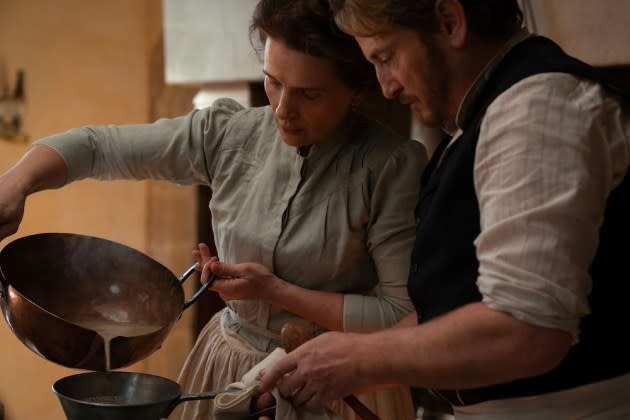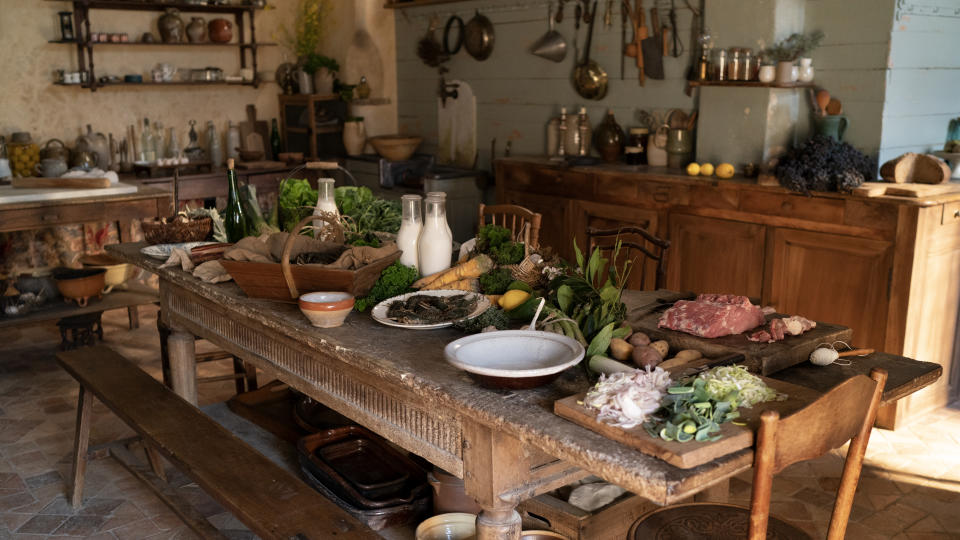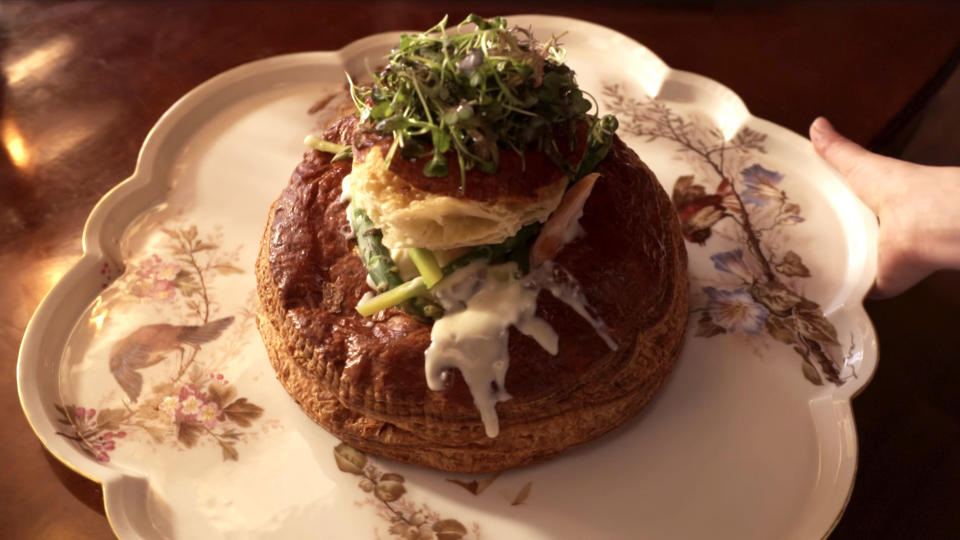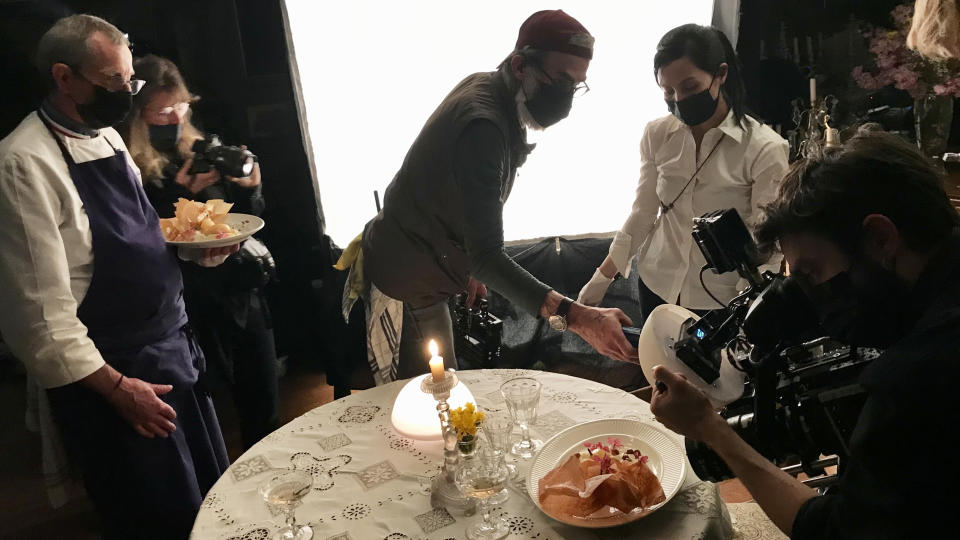‘The Taste of Things’ Consulting Chef Pierre Gagnaire on Why Cooking Is More Than Seduction: ‘It’s Much Deeper Than That’
- Oops!Something went wrong.Please try again later.
- Oops!Something went wrong.Please try again later.
- Oops!Something went wrong.Please try again later.
- Oops!Something went wrong.Please try again later.
- Oops!Something went wrong.Please try again later.

In the months since it has premiered at Cannes, “The Taste of Things,” a lushly romantic love letter to French cooking, has quickly been anointed one of the best food-focused movies ever made. The film, now playing in selected theaters, revolves around the romance between Juliette Binoche’s Eugénie and wealthy gourmet Dodin Bouffant, played by Binoche’s former real-life partner Benoît Magimel. The story of the accomplished cook and her boss and lover simmers along leisurely until it comes to a full boil, all the while showcasing a cornucopia of lovingly-photographed products of the French countryside, from pears and cheeses to veal roast and truffled chicken.
Director Trân Anh Hùng, whose debut film “The Scent of Green Papaya” was described as “a poem for the eyes,” brings a similar sumptuous approach to his latest, layering in flavors of wit, sensuality and despair. Hùng, who has lived in France since moving from Vietnam as a child, worked on “The Taste of Things” for more than seven years, leading up to his best director win at last year’s Cannes Film Festival.
More from Variety
WWII Fashion Drama 'The New Look' Is a Poor Fit for Its Material: TV Review
Anatomy of a Fail: Inside France's Dysfunctional Oscar Committee
Oscars: International Feature - Is 'The Zone of Interest' a Lock to Win?
To nail down the long list of dishes appropriate to the turn of the 20th century, the director started by working with noted food historian Patrick Rambourg. That research led him to bring on distinguished French chef Pierre Gagnaire as a consultant. Each winter, Gagnaire’s eponymous three Michelin star Paris restaurant offers a deluxe take on the classic, comforting dish pot-au-feu, a key plot point in the film.

“I was seduced right away by Hùng, he was determined and subtle,” says the chef. “I realized it could be a formidable relationship.”
But as the years passed without a filming date, the project weathered financing issues and grappled with all the challenges familiar to independent producers, and Gagnaire despaired that it would ever get off the ground. “I didn’t believe it would happen anymore,” he confides. But, “When we finally started, it was an extraordinary adventure.”
The first step was to plan which dishes from over 100 years ago recommended by Rambourg could work on a contemporary film set. “I said this, yes, this no,” Gagnaire explains. For example, “He proposed frogs — and living frogs on a set would be impossible!” Also, items such as river fish are now difficult to find.
“Hùng was very flexible” about the choice of dishes, Gagnaire recalls. “The character of Dodin is a very creative cook, though of course you had to respect the time it took place in.” Gagnaire’s restaurants are known for innovative juxtapositions of ingredients, so Hùng relied on both the chef’s classic technique and his creative approach.

Then, the centerpiece items were selected — including a showstopping vol-au-vent pastry shell filled with seafood, veal with braised lettuce, baked Alaska, a chicken poached with truffles under the skin and a pear dish topped with a wrinkly, ethereal crust that serves almost as seduction.
With the help of his chef Michel Nave, who was on set for the entire shoot, Gagnaire helped make sure the actors would realistically look like experienced chefs.
“I made all the dishes over three mornings, and they were filmed,” Gagnaire recalls. (Here’s hoping for a Blu-ray with special features.)
“These videos were shown to the actors, and they were able to observe the technique, the attitude and the gestures,” he says. This helped Binoche and Magimel learn the movements, but Gagnaire reveals that in a few of Magimel’s scenes, the hands making the dish belong to a professional chef, not to the César-winning actor.
While Nave supervised the day-to-day shooting, often constructing multiple omelettes, 10 veal roasts or 50 poached pears, Gagnaire visited the set to help oversee two of the most challenging dishes, the flaky vol-au-vent pastry and the elaborate pear dessert topped with a fripé, a paper-thin cookie that resembles crumpled fabric. (He also cameoed as a pretentious competing chef).

As exacting and labor-intensive as creating dishes for a top-tier restaurant can be, constructing them to look wonderful and also be filmed is even more difficult, Gagnaire says. “The timing is very complicated, it’s not all like the timing of a restaurant.
“It’s not a television cooking show, it’s a real film with carefully planned camera angles,” he says. “So that meant that lots of products were used.”
When Dodin Bouffant decides to make a humble pot-au-feu for a foreign prince’s gala dinner, it’s a cheeky gesture that non-French audiences might not fully grasp.
“It’s a commoner’s dish. It’s like bibimbap for Koreans, spaghetti for an Italian, miso soup for the Japanese,” Gagnaire explains. “You can make it very sophisticated, but it’s not beef filet, or sirloin. It’s deeply rooted in popular cooking.”
Gagnaire explains that in the beginning of the 20th century, pretentious, elaborate cooking and interminably long meals were de rigueur for impressing princes and powerful people. But in the film, Dodin Bouffant and Eugénie are trying to evolve the tradition of overdone dishes by presenting a dish of the people, though carefully made with the finest ingredients.
Gagnaire likens their thinking to the nouvelle cuisine revolution of the 1970s and ’80s when chefs like Paul Bocuse revolutionized heavy, creamy traditional French cooking with lighter preparations that were “more simple, clear, clean, elegant, more sensual,” says Gagnaire, whose cooking is heavily influenced by the nouvelle cuisine movement.
The film is all about the dance of romance that can be demonstrated by tenderly cooking for another person and watching them experience the food. But Gagnaire doesn’t like to use the word “seduction.”
“It’s much deeper than that,” he insists. “It’s a giving of one’s self through cooking, a deeper generosity, a lot of love.”
Below, watch young Pauline, who is learning to cook from Eugénie and Dodin.
Best of Variety
From Ina Garten to Guy Fieri: Ranking the 14 Best Food Network Hosts
'House of the Dragon': Every Character and What You Need to Know About the 'Game of Thrones' Prequel
Sign up for Variety’s Newsletter. For the latest news, follow us on Facebook, Twitter, and Instagram.

